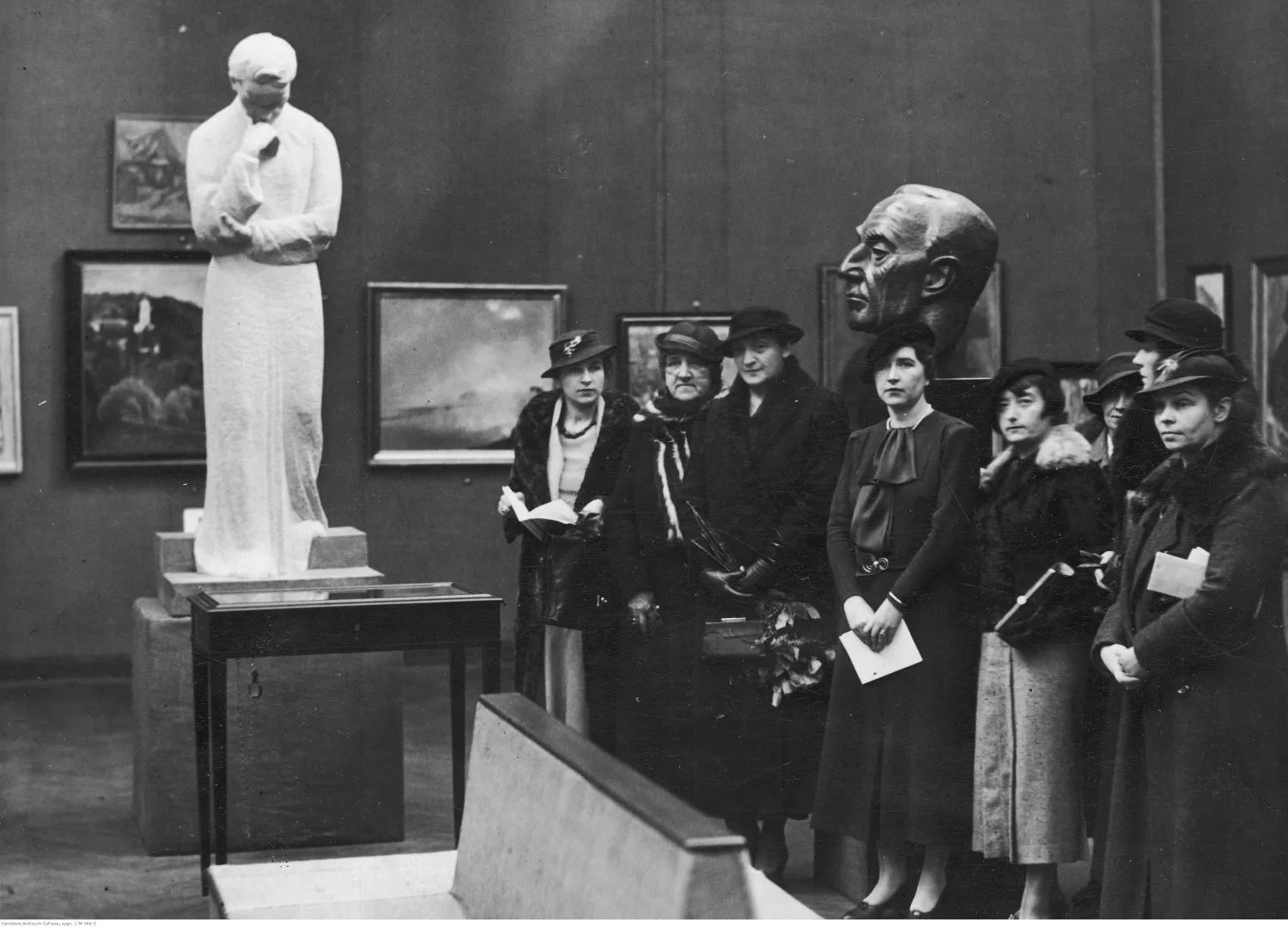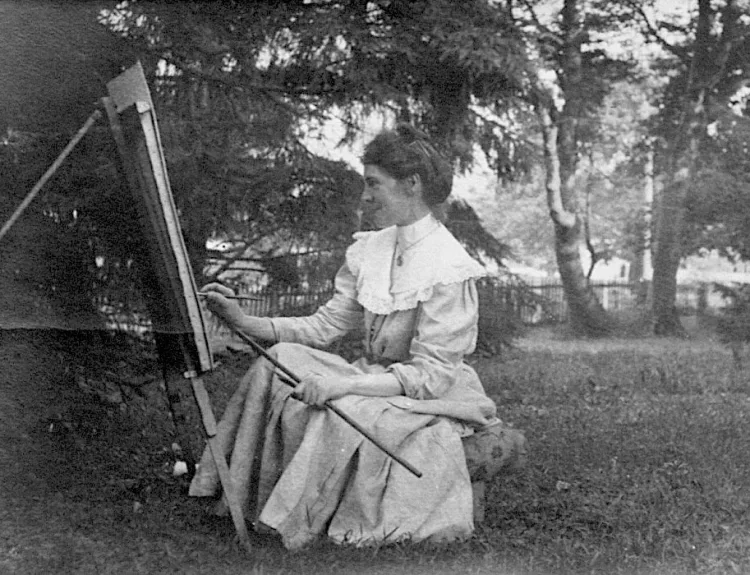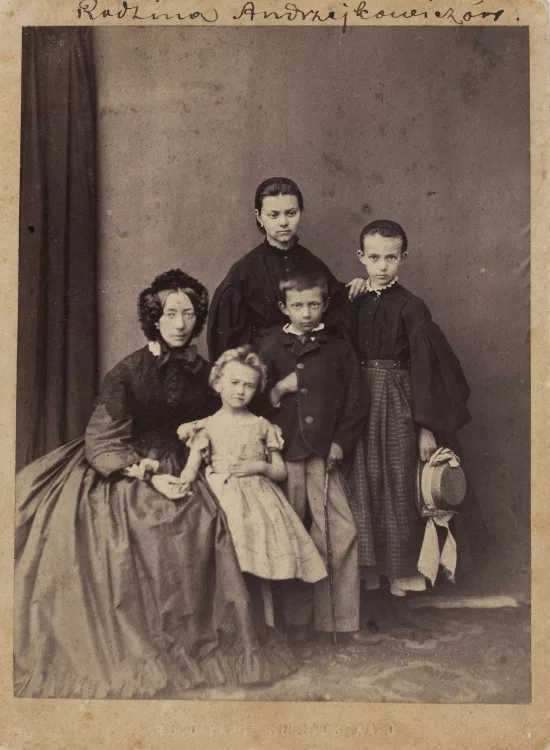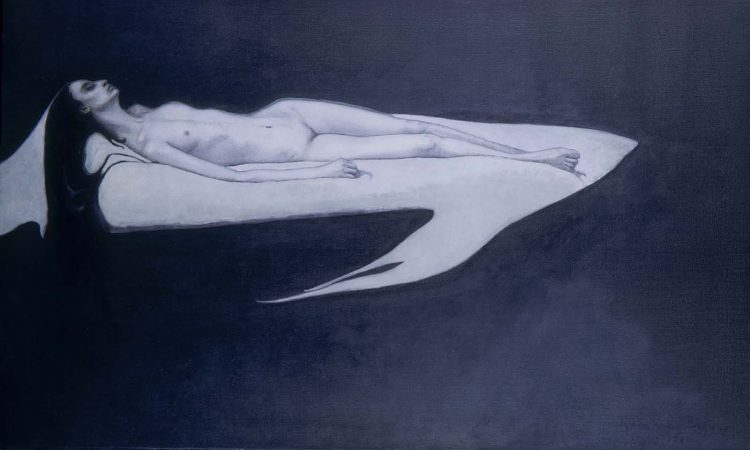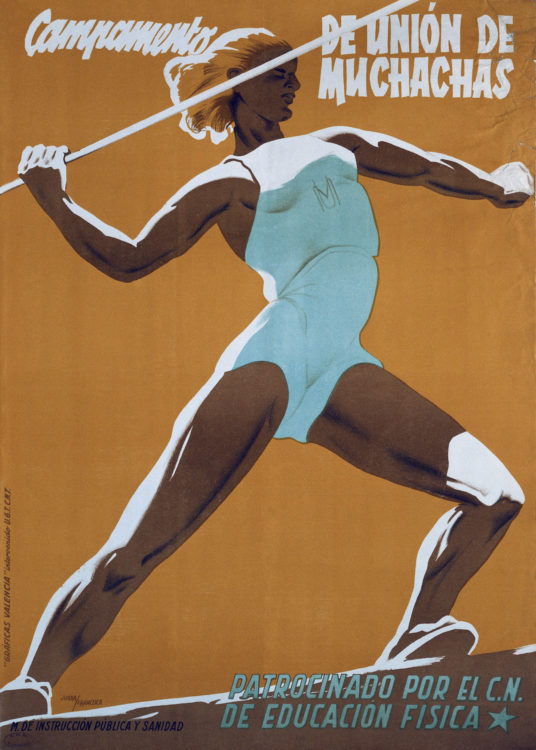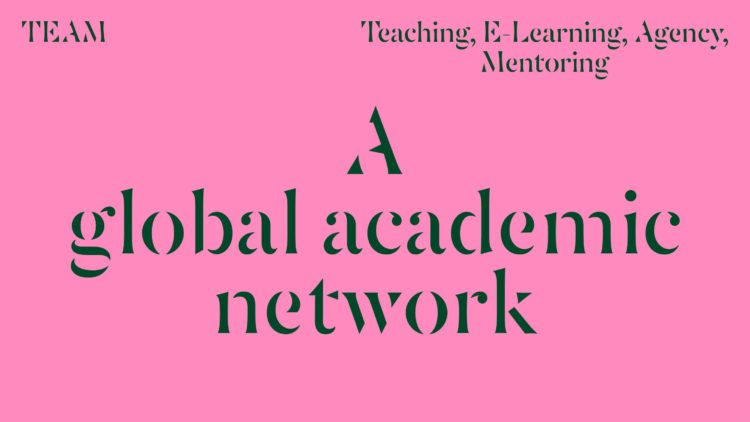Research
Between 24 and 26 August 1930, the founding conference of the International Federation of Business and Professional Women (IFBPW)1 was held in Geneva. It was initiated by Lena Madesin Phillips, an American lawyer and women’s organisations activist, who intensively promoted international cooperation between women. As explained by Dorothy Heneker, the executive director of the IFBPW, since 1929 the Great Depression had proved the interdependence of nations and the necessity of cooperation and understanding2. The Federation aimed at fostering such collaboration between women who were active professionally, amongst them artists, and who were experiencing the negative consequences of the global economic crisis.
During the 1930 Geneva conference, six Standing Committees were created with a specific focus. Amongst them was the Committee of Fine Arts, led by the Italian sculptor Antonietta Paoli Pogliani (1886–1956). The Committee aimed to promote international cooperation between artists by exchanging information about professional opportunities and creating joint initiatives, such as international exhibitions. The latter turned out to be an ambitious, not always successful endeavour to bring women artists together in the era of the growth of nationalism.
The first exhibition of the IFBPW was held in Amsterdam in the autumn of 1933 under the title Exposition d’oeuvres de femmes artistes [Exhibition of works by women artists]. Initially, it was planned to be held in the rooms provided by the Lyceum Club (another international women’s organisation), but it was moved to a more prestigious venue – the Stedelijk Museum. All member countries were invited, and eventually artists from the Netherlands, Poland, the UK, Sweden, Norway, Belgium, France, Spain, Austria, Italy, the USA and Canada showed their works. After some discussion, it was decided that each national federation would take responsibility for selecting works made by its members. As a result, the international exhibition consisted of several national shows brought together. Pogliani was responsible for coordinating all activities, preparing the catalogue, and directing the hanging committee. A catalogue accompanying the exhibition included lists of all works and reproductions of some (artists had to pay if they wanted their works to be reproduced).
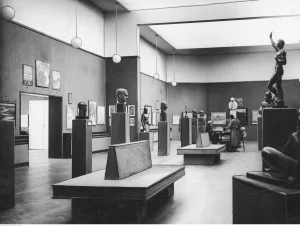
View of the Second Exhibition of Works by Women Artists, organised by the International Federation of Business and Professional Women, Institute of Art Propaganda, Warsaw, October 1934, National Digital Archive, Poland
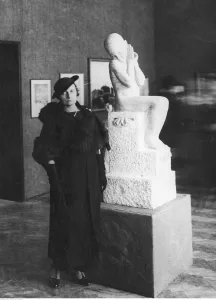
Antonietta Paoli Pogliani with her sculpture at the Second Exhibition of Works by Women Artists, organised by the International Federation of Business and Professional Women, Institute of Art Propaganda, Warsaw, October 1934, National Digital Archive, Poland
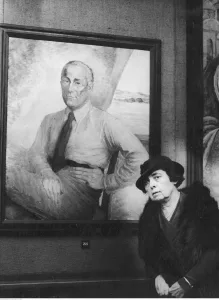
Cornelia Emilian at the Second Exhibition of Works by Women Artists, organised by the International Federation of Business and Professional Women, Institute of Art Propaganda, Warsaw, October 1934, National Digital Archive, Poland
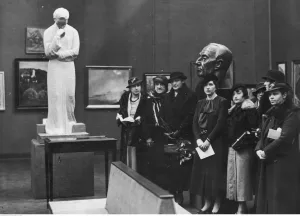
Aleksandra Piłsudska (third from left) visiting the Second Exhibition of Works by Women Artists, organised by the International Federation of Business and Professional Women, Institute of Art Propaganda, Warsaw, October 1934, National Digital Archive, Poland
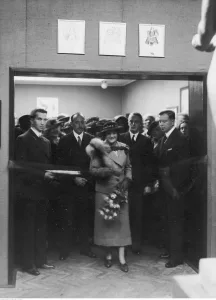
Opening of the Second Exhibition of Works by Women Artists, organised by the International Federation of Business and Professional Women, Institute of Art Propaganda, Warsaw, October 1934, in the middle Maria Mościcka, wife of the President of the Polish Republic, National Digital Archive, Poland
In her introduction to the catalogue, Pogliani wrote that the exhibition’s aim was “to bring working women together and to develop an awareness of the friendship that can unite intellectual women of different countries”3. However, not many women artists participated in the IFBPW exhibitions’ openings; these were usually attended by leaders of the Federation, activists from particular countries and local artists. The vernissage was a good occasion to present the Federation, as can be seen from the press reviews which mention not only the artists but also the organisation of which they were members. The Amsterdam exhibition was well received and extended due to the interest it raised. The reviewers noted, however, that the works exhibited were not necessarily typical or best examples of what was created in particular countries4. The Federation perceived the project as a success because it resulted in the sale of many artworks and “increased interest in our work from artists’ groups,5 which was measured by the number of visitors and reviews6. The decision was made to continue this activity and organise a second exhibition in Poland in the following year.
The Polish authorities supported women artists in their international endeavours, perceiving them as a good means of cultural diplomacy. The organisers of the second IFBPW exhibition were provided with the necessary funds and rooms at the Institute of Art Propaganda. The show was held in October 1934 and presented works by women artists from Czechoslovakia, France, the Netherlands, Italy, Poland, Hungary, the UK and Romania7. Those from outside Europe chose not to participate on this occasion because of the high costs. This exhibition met with a more critical response than the previous one. Many reviews stressed that it could not be considered representative of the art created by women at the time, as it only showed works by members of the Federation. The absence of established French female artists was particularly highlighted. Additionally, overall opinion was negative about the artistic quality of the works exhibited. One reviewer maliciously observed that despite the name of the Federation, the artworks exhibited looked as if they had been created by amateurs, not professionals8.
In the catalogue of the Warsaw exhibition, Pogliani expressed her hope that “the cycle of these artistic manifestations, […] continues its progress across other continents with the aim of bringing women from distant countries closer together by creating new centres of fraternity”9 but further exhibitions were not organised in the subsequent years. However, the idea of such joint initiatives was revisited in 1936, probably influenced by the 1937 Exposition internationale des arts et des techniques appliqués à la vie moderne [International Exposition of Art and Technology in Modern Life], which was being prepared in Paris. This time, the IFBPW decided to cooperate with the Société des Femmes Artistes Modernes (FAM) operating in that city. They jointly prepared the exhibition, entitled Les Femmes Artistes d’Europe exposent au Jeu de Paume [European women artists exhibit at the Jeu de Paume], which opened on 11 February 1937 in the Musée des écoles étrangères contemporaines, housed in the Jeu de Paume.
The FAM was founded in 1930 by the Parisian painter Marie-Anne Camax-Zoegger (1881–1952). She established this group to “showcase, harmoniously gathered, the most beautiful works of the most representative artists from the School of Paris” – that is, women artists from different countries who lived and worked in Paris10. The association’s main activity was its annual exhibitions, organised between 1931 and 193811.
The IFBPW, its Committee of Fine Arts, and the FAM association were founded at the same time and had converging goals. To a large extent, their activity was a reaction to the global economic crisis, which had led, amongst other things, to a significant deterioration in the situation of artists. Rather than fighting for the recognition of women’s right to function in the art world, as previous women’s initiatives had done, these organisations sought to improve the situation of artists already recognised as professionals. The exhibitions served to promote female artists, consequently leading to the purchase of works and facilitating a living from art. In view of the collapse of the art market, it was largely a matter of public institution purchases. For this reason, both institutions sought the support of the governments and authorities in the art world by inviting them to join honorary committees, whose members were mentioned in the catalogues, or to the vernissages. When describing the FAM’s strategy, Paula Birnbaum drew attention to the photographs accompanying exhibition reviews. For example, one of these depicted the group’s leader, Marie-Anne Camax-Zoegger, presenting an exhibition to Marguerite Nivoit Lebrun, the wife of the then French president Albert Lebrun. Similar photographs have been preserved from the opening of the IFBPW exhibition in Warsaw, showing Maria Mościcka, the wife of the Polish President. Strategic objectives also influenced the artistic profile of the art on display – if it can be described as modern, it was certainly not avant-garde.
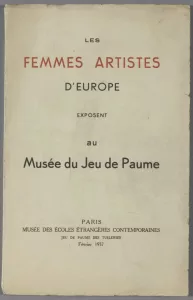
Cover for the catalogue of Les Femmes Artistes d’Europe exposent au Jeu de Paume (11–28 February, 1937), Paris, Musée des écoles étrangères contemporaines, 1937
Since the IFBPW initiated the Femmes Artistes d’Europe exposent au Jeu de Paume, the organisation of this exhibition followed the procedures developed previously by the Federation, but slight modifications were introduced. Each country that decided to take part in the exhibition submitted works, but the final decision was made by a jury on site. The jury consisted of the organisers of the exhibition (representatives of the IFBPW, the French branch of the Federation, the FAM and the museum) and one artist from each participating country. The works, both in the exhibition space and in the catalogue, were arranged according to the nationality of the artists. The catalogue lists artists from fifteen countries: Belgium, Czechoslovakia, Finland, France, Hungary, Italy, Netherlands, Norway, Poland, Romania, Russia, Switzerland, Sweden, the UK and Yugoslavia. In addition, a room with an international school was created to show artists from countries that were not exhibiting. This exhibition differed from those organised by the FAM. Here, all artists, irrespective of their nationality, exhibited together, and their names were arranged alphabetically in the catalogues.
The Parisian press reviewing the Femmes Artistes d’Europe wrote that for the first time “a female ensemble of this importance, such a choice of women artists delegated by the whole of Europe” was presented, somehow ignoring the previous initiatives of both organising institutions.12 Underlying the international character of the show, the press claimed that artists from particular countries did not present original art and that what could be seen was rather “the extension of the French school in Europe than a demonstration of foreign schools.”13 In their view, this did not undermine the quality of the art exposed; it met with acclaim, confirming the growing significance of women’s art on the Parisian art scene.
The IFBPW organised no more exhibitions during the interwar period, presumably because the growing political tensions made international cooperation more difficult. Some reviews mention that the Femmes Artistes d’Europe was to travel to the Metropolitan Museum in New York14, but no confirmation of this has been found. However, in October 1939, the Riverside Museum in New York opened an exhibition presenting International Women Painters, Sculptors, Gravers [of] Australia, Czechoslovakia, France, Greece, Hungary, Italy, Netherlands, Norway, Poland, and Switzerland. As the participation of European women artists was organised by Pogliani, it gathered artworks by many artists presented at the previous IFBPW exhibitions. The New York show seems to have been the last episode of the intensive development of this kind of initiative – international all-women exhibitions – that could be observed in the 1930s. World War II changed the political situation completely, and after it finished women artists had to seek new frameworks for cooperation on a global scale.
This research was partially founded by the National Science Centre, Poland (research project “Globalising History of All-Women Exhibitions”, funding no. 2020/39/B/HS2/00443).
2
Dorothy Heneker, “Editorial: New Bonds of Interest,” Independent Woman, May 1933, p. 1. This journal and other documentation on the IFBPW come from the Papers of Lena Madesin Phillips, 1881–1955. Arthur and Elizabeth Schlesinger Library on the History of Women in America. Radcliffe Institute for Advanced Study.
3
Exposition d’oeuvres de femmes artistes organisée par le Comité International des Beaux Arts /Tentoonstelling van werken van kunstenaressen, georganiseerd door het Internationaal Comitévoor Schoone Kunsten, ex. cat., Stedelijk Museum, Amsterdam (16 September–2 October, 1933), Amsterdam, International Comité voor de Schoone Kunsten, 1933. Quotes from this catalogue and subsequent resources have been translated from French by the author.
4
See for example “Een bijzondere tentoonstelling. Werken van kunstenaressen in het Stedelijk Museum,” De Gooi- en Eemlander : nieuws- en advertentieblad, 24 September 1933, or “De Vrouw in de beeldende kunst. Tentoonstelling in het Stedelijk Museum te Amsterdam”, Algemeen Handelsblad, 16 September 1933. I would like to thank my research assistant Lisa van den Heuvel for collecting and translating fragments of press reviews for me.
5
St. Br., “Malarstwo kobiet zarobkujących”, Express Poranny, 14 October 1934.
6
International Federation of Business and Professional Women, Proceedings of the Board of Directors, Geneva, June 25–28, 1934 (The International Federation of Business and Professional Women, 1934), p. 6.
7
The exhibition was open from 1 to 31 October 1934.
8
St. Br., “Malarstwo kobiet zarobkujących”, Express Poranny, 14 October 1934. Press reviews were collected in The Institute of Art Propaganda Archives, 70, exhibition 32. The Institute of Art, The Polish Academy of Science, Warsaw.
9
IIème Exposition d’œuvres de femmes artistes organisée par le Comité International des Beaux Arts/II Międzynarodowa Wystawa Plastyczek zorganizowana przez Międzynarodowy Komitet sztuk Pieknych, ex. cat., Instytut Propagandy Sztuki, Warsaw, 1934.
10
“Les femmes artistes modernes”, Art et Artisanat, 15 June 1935.
11
For more on the FAM see Paula J. Birnbaum, Women Artists in Interwar France: Framing Femininities, Surrey, Routledge, 2016.
12
L’Imagier, “Les Femmes artistes d’Europe au Musee du Jeu de Paume”, L’œuvre, 14 February 1937, p. 2, https://gallica.bnf.fr/ark:/12148/bpt6k4620475w/f2.image.r=%22Les%20femmes%20artistes%20d’europe%22.
13
L’Imagier, “Les Femmes…”. See also René Barotte, “Les femmes artistes d’Europe exposent leurs œuvres au Jeu de Paume,” Paris Soir, 12 February 1937, p. 7, or Ed. S., “Les Femmes artistes d’Europe”, Journal des debats, 29 August 1937, p. 2, https://gallica.bnf.fr/ark:/12148/bpt6k508682k/f4.image.r=%22Les%20femmes%20artistes%20d’europe%22?rk=21459;2
14
L’Imagier, “Les Femmes…”.
Agata Jakubowska is a professor in the Institute of Art History at the University of Warsaw. She is the author and editor of numerous publications devoted to art created by Polish and Eastern European women artists. Currently, she is conducting a research project entitled “Globalizing the History of All-Women Exhibitions” (2021–2025, funded by the National Science Centre, Poland) and is writing a book entitled Real and Imagined Communities in All-Women Exhibitions.
An article produced as part of the TEAM international academic network: Teaching, E-learning, Agency and Mentoring.
Agata Jakubowska, "All-Women Art Exhibitions Organised by the International Federation of Business and Professional Women." In Archives of Women Artists, Research and Exhibitions magazine, . URL : https://awarewomenartists.com/en/magazine/les-expositions-artistiques-feminines-organisees-par-linternational-federation-of-business-and-professional-women/. Accessed 18 December 2025
